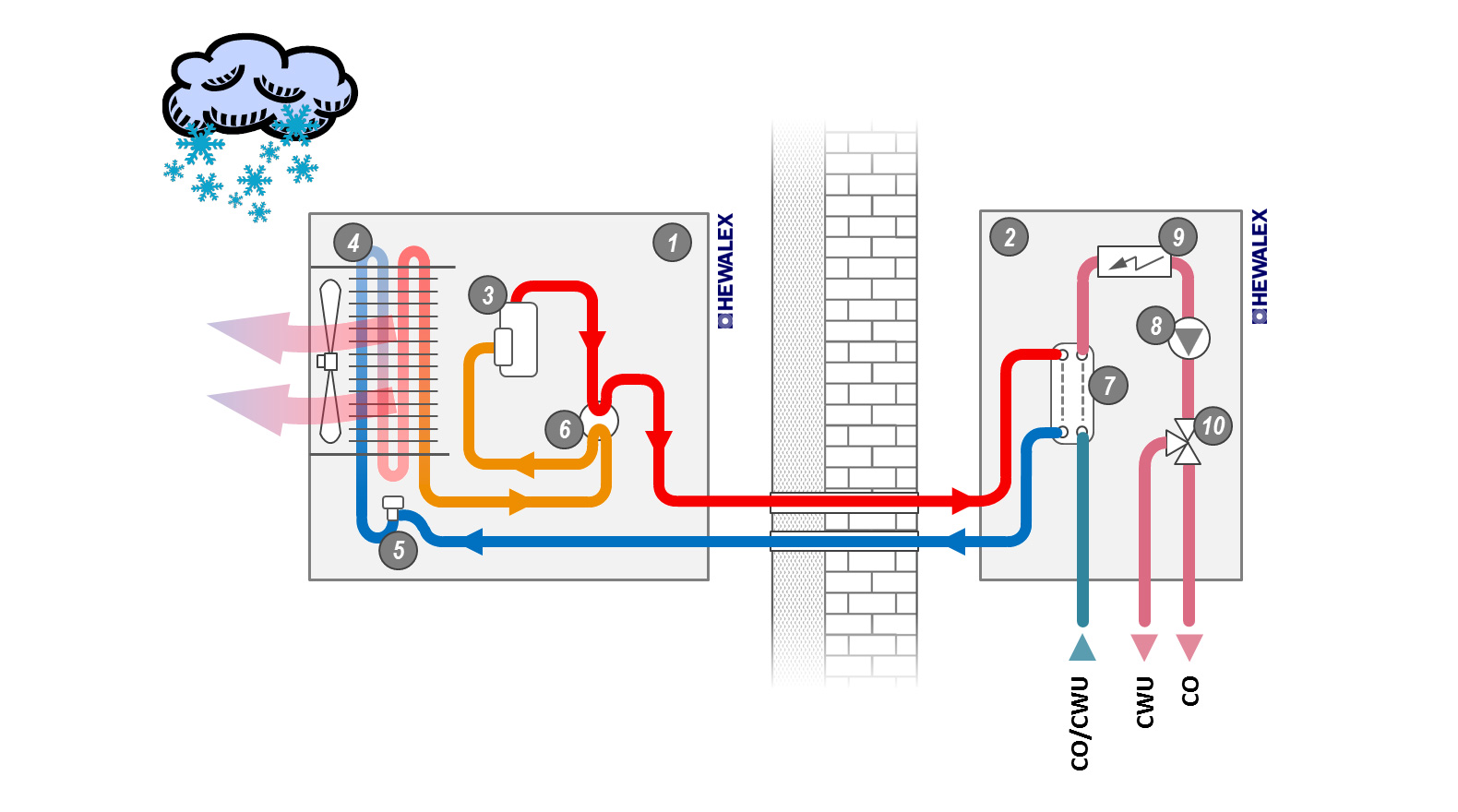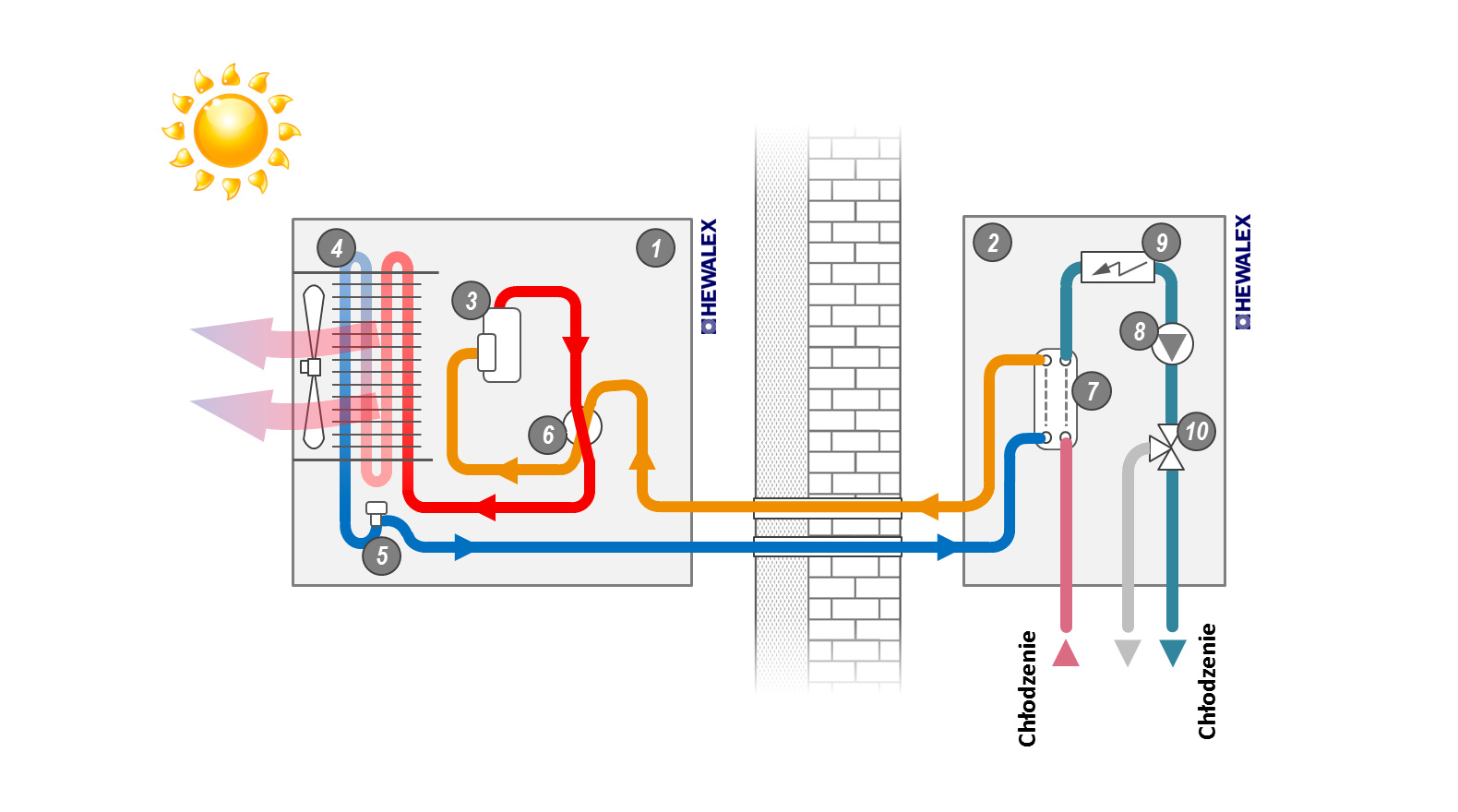Each compressor heat pump consists of four main components – a compressor, an expansion valve and two heat exchangers – a condenser and an evaporator. They are connected by pipes and form a so-called refrigeration circuit filled with working fluid (also called refrigerant). The liquid evaporates in the evaporator due to the heat pickup, its steam is compressed by the compressor, which means that in addition to high pressure, it also reaches a high temperature and then releases the heat in the condenser. Then, as liquid again, it goes to the evaporator, flowing along the throttle element – the expansion valve. In it, as a result of the pressure drop, the temperature also decreases, reaching the value that allows the heat to be collected in the evaporator.
SPLIT air / water heat pump – in heating mode
The outdoor unit (1) is connected to the outdoor unit (2) with refrigerant lines (R410A). The heat received in the evaporator (4) raises the temperature of the refrigerant, which via the 4-way valve is directed to the compressor (3). The refrigerant with increased temperature and pressure gives off the heat in the condenser (7) and returns to the evaporator (4) via the electronic expansion valve (5). The heating water receives the heat from the condenser (7) and if necessary it is reheated in the instantaneous electric heating (9, standard equipment for the PCCO SPLIT 13kW version). The circulating pump (8) directs the heating water through a 3-way diverting valve (10, standard equipment PCCO SPLIT 13kW) to the heating system of the building (CO) or to the coil of the DHW cylinder (CWU).

SPLIT air / water heat pump – in cooling mode
The outdoor unit (1) is connected to the outdoor unit (2) with refrigerant lines (R410A). In comparison to the heating mode, in the cooling mode the refrigerant flow direction changes and the function between the evaporator and the condenser changes, i.e. the evaporator becomes the condenser (4) and the condenser the evaporator (7). Cooling water (eg from Klima convectors or air cooler) gives off the heat in the evaporator (7) and is cooled by the refrigerant. The factor raising the temperature in the evaporator (7) evaporates and flows through the 4-way valve (6) to the compressor (3). After raising the temperature and pressure, the refrigerant is cooled in the condenser (4) and expanded in the expansion valve (5) returns to the evaporator (7) to reclaim the heat from the cooling water.

BENEFITS
The heat pump is the cheapest way of heating the home. For the house 150-200 m2, the annual cost of heating is usually between PLN 1,500 and 2,000. The heat pump is multifunctional – it is the only solution that can heat in the winter and cool in the summer (if we believe in global warming it is better not to downplay the cooling function). So it both heats, cools and produces hot water. It can also act as a recuperator in the air conditioning system and can dry the air. It is a completely maintenance-free solution, subject to total automation – after all, the heat pump is a 100% electric device.
In Europe, the heat pump is supported as a pro-ecological solution, because it replaces the “dirty” ecologically heated oil with a very “clean” electric heating, which in fact is a heat pump. Also, it significantly reduces CO2 emissions. In Poland, this is a problematic argument, as coal-fired power plants predominate in our country, whereas for the production of 1 kWh of electricity, we need to use approx. 3 kWh of thermal energy of the burned coal. Skeptics will say that in the final result 1 kWh of heat energy requires 1 kWh of thermal energy of coal, that is, in terms of CO2 emissions, the situation is similar to that for a coal boiler. However, the burning of coal in the power plant is becoming “cleaner” ecologically. Moreover, in the future the share of coal in electricity production in our country will decrease.
Political support for the development of heat pumps as a solution to reduce CO2 emissions is very strong. Many countries in Europe receive subsidies and concessions from the European Union budget, which policy tires to make heat pumps a standard solution for heating the houses.


